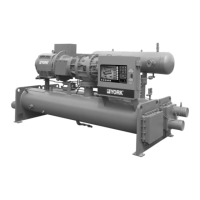15JOHNSON CONTROLS
FORM 160.80-EG1 (808)
REFRIGERANT ISOLATION
The condenser shell serves as a refrigerant receiver
to store the system charge during servicing. Manually
operated isolation valves are located at the inlet and
outlet of the condenser. Valves are also provided to fa-
cilitate removal of the refrigerant from the system when
necessary.
OPTIVIEW CONTROL CENTER
General
The chiller is controlled by a stand-alone microprocessor-
based control center. The chiller control panel provides
control of chiller operation and monitoring of chiller sen-
sors, actuators, relays and switches.
Control Panel
The control panel includes a 10.4 inch diagonal color liquid
crystal display (LCD) surrounded by “soft” keys, which
are redened based on the screen displayed at that time,
mounted in the middle of a keypad interface and installed
in a locked enclosure. The screen details all operations
and parameters, using a graphical representation of the
chiller and its major components. Panel verbiage is avail-
able in other languages as an option with English always
available. Data can be displayed in either English or Metric
units. Smart Freeze Point Protection will run the chiller at
36°F (2.22°C) leaving chilled water temperature and not
experience nuisance trips on low water temperature. The
sophisticated program and sensor monitors the chiller wa-
ter temperature to prevent freeze-up. When needed, Hot
Gas Bypass is available as an option. The panel displays
countdown timer messages so the operator knows when
functions are starting and stopping. Every programmable
point has a pop-up screen with the ranges included, so
the chiller can not be programmed to operate outside of
its design limits.
The control panel includes a thermal ice storage control
mode which enhances system performance during ice
building operation when compared to standard cooling
logic. In thermal storage control mode, the chiller will
operate at 100% load until the setpoint shutdown tem-
perature is reached. To add greater operating exibility
and eliminate unnecessary chiller cycling, two different
Low Water (Liquid) Temperature Restart Thresholds are
programmable, one for the ice mode and one for the stan-
dard cooling mode. The chiller has the capability to remain
in the standard control mode for temperatures between
20°F to 70°F (–6.7°C to 21.1°C) for applications involving
a process cooling duty that requires leaving chilled liquid
temperature setpoint control.
The chiller control panel also provides:
1. System operating information including:
• Return and Leaving Chilled Water Temperature
• Return and Leaving Condenser Water Tem
perature
• Evaporator and Condenser Saturation Tem
perature
• Oil Pressure at Compressor and Oil Filter
Differential
• Percent Motor Current
• Evaporator and Condenser Saturation Tem
perature
• Compressor Discharge Temperature
• Oil Temperature
• Percent Slide Valve Position
• Operating Hours
• Number of Unit Starts
2. Digital Programming of Setpoints Through The Uni-
versal Keypad Including:
• Leaving Chilled Water Temperature
• Percent Current Limit
• Pull-Down Demand Limiting
• Six-Week Schedule For Starting and Stopping
The Chiller, Pumps and Tower
• Remote Reset Temperature Range
3. Status Messages Indicating:
• System Ready To Start
• System Running
• System Coastdown
• System Safety Shutdown – Manual Restart
• System Cycling Shutdown – Auto Restart
• System Prelube
• Start Inhibit
4. The text displayed within the system status and sys-
tem details eld is displayed as a color-coded mes-
sage to indicate severity: red for safety fault; orange
for cycling faults; yellow for warnings; and green for
normal messages.
5. Safety shutdowns are enunciated through the display
and the status bar, and consist of system status, sys-
tem details, day, time, cause of shutdown, and type of
restart required. Safety shutdowns with a xed speed
drive include:
• Evaporator – Low Pressure
• Evaporator – Low Pressure - Smart Freeze
• Evaporator – Transducer or Leaving Liquid
Probe

